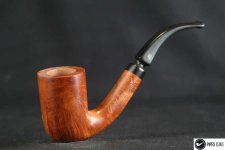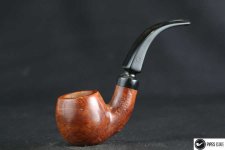As many ways of doing that as there are packing and smoking a pipe.Any suggestions for removing the oxidation/greening?
School me on Vulcanite
- Thread starter Briar Lee
- Start date
You are using an out of date browser. It may not display this or other websites correctly.
You should upgrade or use an alternative browser.
You should upgrade or use an alternative browser.
SmokingPipes.com Updates
Watch for Updates Twice a Week
Yep, even then it was referred to as brindle.And really the name "Cumberland" comes from Dunhill, they used this type of rod on a series they named "Cumberland" many years ago.
@sasquatch why do you prefer acrylic from a pipe makers stand point? From my short stint making pipes, I found vulcanite much, much easier to work with but as a pipe smoker I prefer acrylic for the mere fact that it doesn’t oxidize.
Bingo. I hate working with acrylic, it's grippy, tough, and unpleasant to tool with the exception of polishing. But I also hate green stems and my feral-mammal saliva attacks vulcanite pretty badly in many cases. I also smoke very much for the flavor of the tobacco, and adding a rubbery taste to that now bothers me. I think I have two ebonite stems and about a dozen acrylic in what I smoke. I'm convinced that when people smoke grubby old pipes for 5 years and then buy a mid-grade Italian pipe with an acrylic stems and it's HEAVEN, a big part of the equation is that they aren't tasting sulfur and rubber with every sip.@sasquatch why do you prefer acrylic from a pipe makers stand point? From my short stint making pipes, I found vulcanite much, much easier to work with but as a pipe smoker I prefer acrylic for the mere fact that it doesn’t oxidize.


So here's a couple of those stems "in the wild". Fitted, polished, bent. This is how pipes are made. Now, in a one man shop, the rod would have been cut to a length that suited the pipe, the resulting stem being a better aesthetic match. But that's "next level" stuff. What we are looking at is typical factory made pipe process.
Little shout out to this eBayer for stealing his pics too, pipes-estate in France, they have a butt load of neat pipes for sale.
Cumberland is a rod made (traditionally) from a mix of red and black ebonite. It can be wrapped in sheets or done as a group of long rods crushed together, which is a much nicer presentation. There are now many colors available, SEM in Germany has pushed the envelope on food-grade colorants for the ebonite.
View attachment 105830
You can see the red streaking pretty well here in the stem.
What about oxidation?
Thanks
It will oxydize similar to black ebonite. Some of the colors are less prone to it than others, I have a blue rod that is like rock to work with, and it oxydizes less or at least seems to show it less than the black stuff.
At the end of the day, if you want a maintenance free stem then you have to go to acrylic or juma or polyester ... something that isn't rubber based.
At the end of the day, if you want a maintenance free stem then you have to go to acrylic or juma or polyester ... something that isn't rubber based.
I'm interested that the best Vulcanite is German. The most persistently oxidizing stem I've ever had -- it turned gritty gray the first smoke after it was a polished -- is on a pipe stamped "West Germany," though of course that doesn't categorically mean the stem material was German, or the good stuff. I soon had the stem replaced with tortoise shell colored acrylic, and now it is a great pipe.
Juma : soft as vulcanite, doesn't oxidize.
Jason is making my pipe with Eldritch, he says it doesn’t oxidize.
@sasquatch
What do you guys think of Eldritch?
All vulcanite will eventually oxidize, just the nature of its composition. Some may take longer due to lower sulphur content, but in time it will. The resin Chris Kelly uses is soft like vulcanite but not vulcanite.Jason is making my pipe with Eldritch, he says it doesn’t oxidize.
There just isn't ebonite on every street corner any more. The germans have a couple factories, Schonberger and New York Hamburg, and they make very good rods, very clean, no bubbles. The Japanese stuff feels a little different, I don't know about oxydation with it, better or worse. And there's ebonite out of India that is just poor, not really good enough for pipe stems. And I don't really know of any other sources.I'm interested that the best Vulcanite is German. The most persistently oxidizing stem I've ever had -- it turned gritty gray the first smoke after it was a polished -- is on a pipe stamped "West Germany," though of course that doesn't categorically mean the stem material was German, or the good stuff. I soon had the stem replaced with tortoise shell colored acrylic, and now it is a great pipe.
When I buy a pipe, I prefer vulcanite, because it is traditional, decidedly softer to clench, and a little less glaringly shiny. Recently, I've bought a couple of pipes that were listed with vulcanite stems, but clearly were not when they arrived. Luckily for me, I like acrylic for all the standard reasons, easy to clean and non-oxidizing. But I think the youngsters who are assigned to write up specs on pipes just aren't that savvy on the distinction. First choices for me are always no coating in the chamber and a vulcanite stem, but if the pipe is otherwise suitable, I'm fine with it. For me, life is too short to debate these points. I pack it and smoke. If I needed a pipe to have specific features, I'd call and discuss it with a senior staffer.
All vulcanite will eventually oxidize, just the nature of its composition. Some may take longer due to lower sulphur content, but in time it will. The resin Chris Kelly uses is soft like vulcanite but not vulcanite.
I didn’t know Eldritch was Vulcanite, and I assumed if Jason said it didn’t oxidize, then it didn’t... hmm ?
I have a couple of pipes with juma stems that Scottie Piersel made for me. It's a great looking material, was developed as a substitute for ivory, along with other uses. Just don't use alcohol to clean it.
It's not vulcanite, it's an alternative that Chris formulated for those that prefer softer stems. It's very similar to juma. To my knowledge, vulcanite is the only stem material that oxidizes.I didn’t know Eldritch was Vulcanite, and I assumed if Jason said it didn’t oxidize, then it didn’t... hmm ?
The knife industry makes great use of it for handles and scales. I'm liking it more than vulcanite.It's a great looking material, was developed as a substitute for ivory, along with other uses. Just don't use alcohol to clean it.
I think Bakelite does as well.It's not vulcanite, it's an alternative that Chris formulated for those that prefer softer stems. It's very similar to juma. To my knowledge, vulcanite is the only stem material that oxidizes.
Chris? ?It's not vulcanite, it's an alternative that Chris formulated for those that prefer softer stems. It's very similar to juma. To my knowledge, vulcanite is the only stem material that oxidizes.







